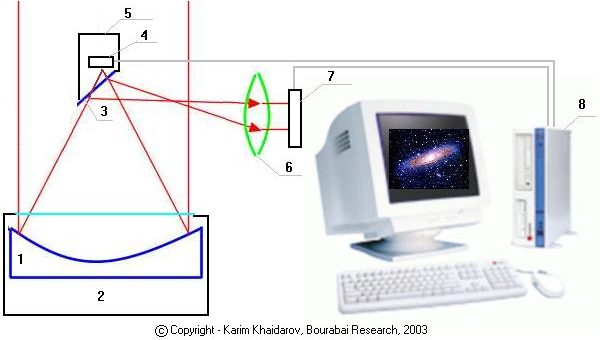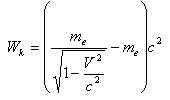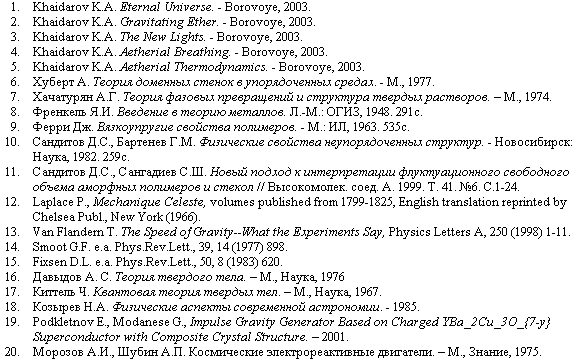main page
list of papers
library
© Copyright - Karim A. Khaidarov, December 30, 2003.
FAST GRAVITATION
Dedicated to the bright memory of my daughter Anastasia
Discovery is seeing what everybody else has seen,
and thinking what nobody else has thought.
A. Szent-Gyorgyi
Taking as a fact [1] the presence of the ether in the Universe, united
quasi-isotropic, quasi-incondensible and elastic medium, being the main
basic matter, the carrier of the whole energy, all processes, occurring in
the Universe, and taking for the base of beliefs about it working model [2-5],
presenting it in the manner of twocomponent medium - corpuscular and phase,
we will consider some questions of mechanical potential of the ether and
resulting from decision of these questions new methods, allowing increase
the possibility to see up to limits of actual, present Universe, not a
past Universe, the possibility to overcome the space quicker than light.
The Structure of Ether
According to developing working model of the ether [2-5],
it is the medium, consisting of corpuscules - amers.
The Amer is a practically incondensible, elastic spherical particle,
which can have two values of velocity: zero and local velocity of light.
Amer has radius, found by present author in [2], equal
ra =
1.6156·10 -35 [m]
Still amers, coupled in pseudo-solid or in pseudo-liquid
body, present by itself a unit of corpuscular ether - domain.
Amers, moving at the speed of light, are borders of domains, named by us
earlier as phase ether. As it is stated earlier [2], the ether inheres
under the action of very large potential, equal square of velocity of light.
In usual conditions of ether temperature, domain has
2.7·1063 amers, and its size commensurable with the size of electron.
The borders of domains are exceedingly fine, since the part of phase ether
is very small even in a dense substance.
Contents of the phase ether in substance equals [4]
|

Fig. 1.
Ether domain structure. Moving of the phase ether along interdomain borders.
[J. C. Maxwell, 1861]
|
Nkg = 5.01 ·1070 [vac/kg]
A density of empty ether depends on local gravitational
potential and it is less on much orders else. Under the action of power of
gravitation, which source is the substance, ether "decompaction" occurs,
that is to say "bulge" of walls of ethereal domain occurs.
Bringing a respect to great predecessor, we will show
J. C. Maxwell's picture of the ether. (Fig. 1).
|
In real situation the wall of domain can not be thickenned
and it is "mono-amereal", that is to say its thickness is one amer only
up to density of substance
|
ρ = Nam ra /RdNkg = 8.1·1011 [kg/m3],
| (1)
|
where Nam is amount of amers per cubic meter,
Rd = 2.25·10-14 [m] is a radius of domain.
Thence very important conclusion follows: amers move along
borders of domain under action of shear forces, that is to say with a shift
velocity of the ether, which is defined in [3] by ether shear modulus G
and dynamic density of the ether ρ
|
c = √(G/ρc) = 2.997926·10 8 [m/s],
| (2)
|
Naturally this velocity is a velocity of light, which is
typical for all observed forms of moving of the phase ether - free amers.
The Phase Ether Moving
Onward motion in the ether is presented by the phase
ether. This motion has two main opposite and compensating each other flows
of amers, solving eternal problem of sources - discharges in three-dimensional
space:
- Moving the phase ether (the gravitons) at the speed of
light is radial from gravitating bodies along domain borders.
With remoting from gravitating bodies these borders (domain walls) become
more resolved.
- The drift of domain walls, and hereunder domains
themselves to account of fraudulent interaction [6] to the side of domains,
having greater internal energy [7] with the second Space velocity of local
gravitational pit. The drift occurs to account of condensation of amers
on the one sides of interdomain gap and evaporation on the other side
under the action of gradient of potential (the pressure) of the ether.
At that situation the density of interdomain walls
defines local gravitational potential, but difference of their density defines
gradient of gravity field. That is naturally results from classical
principle of balance. However all of that is only "superstructure" on
corpuscular ether, providing mechanism of sources - discharges in the ether,
the foam on the surface of corpuscular ether ocean.
Real Ether Potential. Statics of the Ether.
Two-component ether is in the state of all-round
compression. That is a main reason of acting power in him.
We will give it quantitative estimation.
On base of knowledge of parameters of ether domain structure,
got in [5], and the temperature of the ether, it is possible to define the
steady-state pressure in the ether. For this goal, considering that whole
ether energy is energy of elastic deformation of amers, it is possible to write
for steady-state pressure in the ether
|
pe = kT /Va = 2.1265·10 81 [kg / ms2],
| (3)
|
where k - is Boltzmann's constant ( recalculating factor of
[J/nit] to [oK] ),
T is ether temperature (Cosmic Background Radiation) 2.723 [oK],
Va = 4πra3/3 = 1.76793·10-104 [m3]
is amer volume, ra is amer radius.
Got value and mechanism of forming of phase ether around
substance are the main forces, acting within the ether. Any local change
of pressure within the ether, caused by moving of phase ether,
entails corresponding force, returning outraged part of ether to
position of balance. That is just gravitation.
Thereof it is possible to draw a conclusion that amers are
even so compressed. Consequently bulk modulus K for them is not
equal infinity. We Try to find it. At first we will find, how much is
amer compression. We will do it on indirect sign, as follows, on difference
of inter-domain pressure and ether Young modulus Eo,
found by present author earlier in [2].
Inter-domain pressure will find similarly as in (3)
|
pd = kT /Vd = 7.85317·1017 [kg / ms2],
| (4)
|
Thence factor of compression is
|
kp = (Vo – V) / V = (pd – Eo) / Eo = 0.03354,
| (5)
|
where Vo is volume of free amer, V is volume
of compressed amer.
Given value corresponds to typical value of three-dementional
share of free volume [8], fluctuate free volume [9-11], being universal
feature of all amorphous vitreous solids and its melts.
From (5) it is possible to find a bulk modulus, (factor of three-dementional
bounce)
|
K = pe / kp = 6.34·1082 [kg / ms2],
| (6)
|
In spite of the fact that velocities of phase ether
and moving of domain borders are limited in velocity of light -
shear velocity of waves in the ether, the longitudinal (sonic) velocity
must exist in corpuscular ether, which is defined by Pierre Laplace's
following formula
|
cp = √(K/ρl) = 2.1626·10 24 [m/s],
| (7)
|
The Velocity (7) is a true velocity of gravity propagaton
in corpuscular ether. This value excludes the unsolved dynamic paradoxes in
theories of gravitation, which appear in models with limiting light velocity
propagation of gravitational interactions.
It exceeds lower estimation of propagation velocity of gravitation, which
gave by great Pierre Laplace [12] - 1017 [m/s], lower estimation
of Tom Van Flandern - 1019 [m/s] [13].
We note that value of Poisson's ratio of corpuscular ether
differs from 0.5 so little, that it is comfortable to display in amount
|
μ = 0.5 - Δμ = 0.5 - El /6K = 0.5 - 1.0·10 -33,
| (8)
|
On the other hand, integral on time stillness of intradomain
amers on the whole visibility is very high. The multiple experiments on
measurement of corpuscular velocity of light [St. Marinov, M.D.Torr - P.Kolen
and others], measurements of Doppler-effect of Cosmic Microwave Background
(ether black-body radiation) [14, 15] have shown, that independently from
motion of celestial bodies, macroscopic (statistical) velocity of intradomain
amers is a zero both in terrestrial, and intergalactical scales. Solar system
moves comparatively this component of the ether at the speed of 390 ±30 [km/s].
Ethereal phonons
It is naturally to assign the question: is it possible to
observe the longitudinal waves in the ether, which correspond to the sonic waves
in usual substances?
For that, it is necessary to define its characteristics.
Naturally, the phonons in crystalline materials are the most close analogue
of these waves [16,17]. Considering characteristics of phonons, it is possible
to notice that they have such discriminating feature, as absence of particle
- "kern", as photon has. So phonons can scatter, be formed and disintegrate
easier, than photons.
They can be refracted and reflected when turning in mediums, having different
from usual wave resistance (impedance).
Changing the density of phonons brings the change of thermodynamic condition
of electrons, that is to say change of the electric resistance of material.
Pulse an phonons is sent to torsion balance (pendulum).
Actual Universe Observation
Probably, the first person, who has found ethereal phonons
is a genious russian astronomer N. A. Kozyrev [18]. He placed the resistor in
focus of telescope, shielded from rays of stars, and got the signal from stars
in its present position, computable it beforehand on vector of its velocities.
The Results of these experiments there were very unstable, since mirror of
telescope practically does not reflect the gravitational waves. So author
of current article is offerred advanced variant of telescope for observation
of starry sky in gravitational waves - ethereal phonons (see Fig. 2).

Fig. 2. Advanced Kozyrev telescope
( 1 – superconducting focusing mirror,
2 – cryogenic camera, 3 – optical deflecting mirror,
4 – sensor resistive matrix, 5 – electromagnetic shield, 6 – optical focusing system, 7 – optical matrix,
8 - computer, 9 - puls of longitudinal phonon, 10 - body phonon(?), 11 - puls of transverse phonon)
The essence of improvement is concluded in using the mirror,
cooled up to condition of superconductivity. The last has the wave resistance,
sharply differrent from empty ether (the vacuum) and materials in it that
brings to reflection of gravitational and transverse ethereal phonons.
Besides for reception of normal two-dimensional image the resistive matrix,
giving the image of actual Universe (the stars in present position)
is aplying. The Matrix is placed into shield, protecting it from influence
of light and other electromagnetic hindrances. As a matter of convenience
adjusting and undertaking the differential analysis optical - gravitational
scene in telescope can be an usual optical tract.
Experimental Reception of Ethereal Phonons
The first experimental reception of ethereal phonons was
made by genious russian experimentor Eugene Podkletnov [19].
That its known experiment of bombing superconducting dartboards by
high-energy electrons (see Fig. 3)

Fig. 3. Podkletnov's experiment and its explanation
(1 – bombing device, 2 – pendulum sensor, 3- phonon sensor, 4 – oscilloscope,
5 - electron, 6 – de Broglie's wave, 7 – superconducting target, 8 – ethereal phonon)
At runaway of electrons in potential electric field it gains
kinetic energy, proportional its inert mass, which increases to account of
velocity up to value

where me is mass of electron at rest,
V is a velecity of electron,
ñ - transversal (shear) velocity in the ether.
For deduction of electron's mass at rest, this mass
defines kinetic energy of electron, being kept in de Broglie's wave

At achievement of superconducting dartboards, having
sharply different from empty ether wave resistance, electron, unlike its
de Broglie's wave, gets into thick of dartboard, sharply losing velocity.
The de Broglie's wave can not get into superconductor and is reflected
from it, being the ethereal phonon.
Neutral to electromagnetic phenomenas, ethereal phonons
pass practically trough any material except superconductors without hindrance.
The addition to Podkletnov's experiment is shown on Fig. 2.
There is a system of phonon speed measurement, proposed by author of
present article. It consists of two sensors 3, installing apart on route of
phonon moving and having symmetrical connection on length to oscilloscope 4.
These sensors can be both high-frequency piezoelectric microphone, or
simply resistant sensors. At placement of sensors on distance 30 metres
we must get on screen of oscilloscope a picture, like shown on picture.
On mark zero we must see the reaction of sensors on longitudinal phonons,
having velocity on much orders exceeding of velocity of light, on mark 10
nanoseconds probably we will see the response from three-dementional phonons,
but on mark 100 nanoseconds - response from transverse phonons, spreading at
the speed of light.
Podkletnov's Jet is the Basic Cosmic Engine of the Future
Described experimental installation even though it
does not generate longitudinal, but only transverse phonons, is an unique
prototype of cosmic engines of the future. Its specific pulse, which limits
puts only of energy capacity of on-board power station, exceeds known cosmic
motor installation on much orders [20]. The Factor of transformation of energy
in reactive pulse is limited only by toughness of superconductive screen,
reflecting phonons. At voltage of runaway 5 MV on 10 times exceeding energy of
electron mass at rest, factor of transformation of electric energy in kinetic
energy of motion will be nearly 90%.
Conclusions
THe insolvency of relativistic looks at nature of Cosmos
was experimentally proved by present author in [1] . Developped working model
of the ether and gravitational interactions within ether [2] have allowed to
throw light upon nature of matter [3] and explains unexplained before phenomena
of gravitational variations [4]. Prepaired theoretical base has allowed to
develop in work [5] working model of the ether up to possibility of using
the thermodynamics in ether theory.
The revising of gravitational potential essence in present
work has brought the author to classical notion of mechanical power and has
allowed to define the velocity of fast gravitational interaction. Proposed
expansion a working model of the ether has allowed to explain Kozyrev's and
Podkletnov's experiments, offer the direction of development of new actual
astronomy and confirm the direction of Space motor building, opened by
Eugene Podkletnov.
References

Karim Khaidarov
Borovoye, December 29, 2003.
Date of registerred priority: December 30, 2003.
main page
list of papers
library






